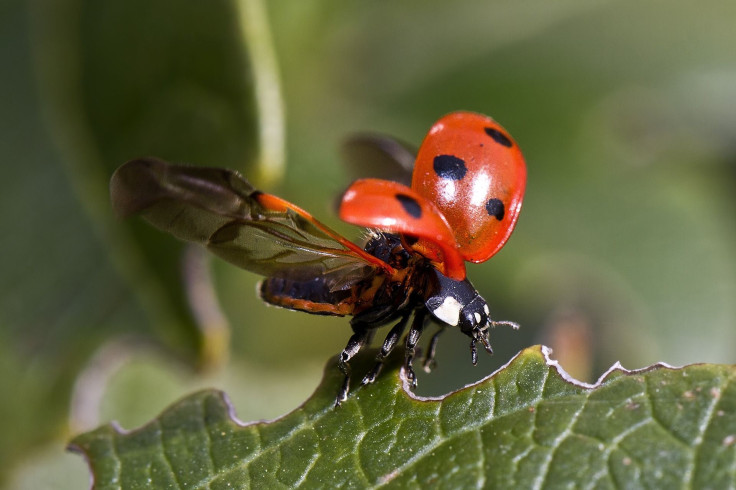Scientists Capture Movement Of Ladybug Wings For First Time [VIDEO]

A ladybug’s protective shell opens upward like the doors of a Lamborghini before its delicate wings unfold and carry it away.
Scientists have captured slow-motion video of this mechanism on a ladybug and gotten an inside look at it for the first time, after replacing the two-piece protective layer, the red and black polka dot elytra, with an artificial transparent one. National Geographic explained that the elytra have previously blocked the view of the folding wings, which have intrigued scientists because they are “flexible enough to fold intricately, yet strong enough to fly.”
Read: “T. Rex” Ant Is a Scared Cannibal
The transparent cases that were grafted onto the ladybug (video below) show the bug slowly pulling in the wings.
Ladybugs, also known as ladybird beetles, are beetles that are usually shorter than half an inch long with short legs and antennae and bright-colored protective cases, which are what have made them iconic. Those cases vary among the different species of ladybugs — there are thousands — and can include the colors red, yellow, orange and black.
Polka dots are a tool for teaching predators to stay away from them. In conjunction with a bad-tasting fluid that they release from their leg joints, the bright colors teach the predators to stay away. The bugs may also play dead.
That foul secretion from their legs could be how some ladybugs got a reputation for being poisonous, but they are not toxic to humans, although they may have an effect on smaller creatures.
The beetles are omnivores, eating both insects and insect eggs as well as plants. With their eclectic appetite, farmers often use ladybug species to stop pests like mites and other insects that could feed on their crops. Other ladybug species, however, are hungry enough to destroy plants themselves.
Apart from helping agriculture, the beetles now could play a role in engineering. According to National Geographic, the design of the soft but strong wings could teach engineers a thing or two.
Read: This Is What Passed for Insect Romance in Prehistoric Times
It wouldn’t be the first time an insect has influenced science. Discover magazine notes that the structure of a butterfly wing that gives it color without having to rely on an actual pigment served as an inspiration for a type of screen display for electronic devices. The wings act sort of like a prism and reflect certain colors to the viewer’s eye, so the engineers created screens that reflect available light rather than relying on illumination from within the screen, which also prevents the display from getting washed out when outdoors. Inventions that imitate functions found in nature are referred to as biomimicry.
Ladybugs have also been used for medicinal purposes. Encyclopaedia Britannica says that traditional medicine has used the beetles to cure measles, toothaches and even colic in babies.
© Copyright IBTimes 2024. All rights reserved.





















